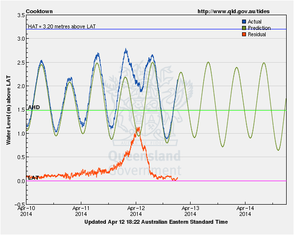Storm Science
What is a Storm?
A storm is any disturbed state of an astronomical body's atmosphere especially affecting its surface, and strongly implying severe weather.
A storm may be marked by strong wind, hail, thunder and/or lighting (a thunderstorm), heavy rain and strong winds (as with a tropical cyclone).
Storms generally lead to negative impacts to lives and property.
Types of Storms
A Thunderstorm is a form of turbulent weather characterized by the presence of lightning and its acoustic effect (thunder) on the Earth's atmosphere.
The cloud type associated with a thunderstorm is cumulonimbus.
Thunderstorms are usually accompanied by strong winds, heavy rain and sometimes snow, sleet, hail, or no precipitation at all.
Thunderstorms may line up in a series or rainband, known as a squall line. Strong or severe thunderstorms may rotate, known as supercells. Most thunderstorms move with the mean wind flow through the layer of the troposphere that they occupy.
A tropical cyclone is a storm system with a closed circulation around a centre of low pressure, fueled by the heat released when moist air rises and condenses.
The name underscores its origin in the tropics and their cyclonic nature. Tropical cyclones are distinguished from other cyclonic storms such as nor'easters and polar lows by the heat mechanism that fuels them, which makes them "warm core" storm systems.
Tropical cyclones form in the oceans if the conditions in the area are favorable, and depending on their strength and location.
Atmospheric Pressure Systems
The force per unit area of the atmosphere above the earth’s surface is called Atmospheric Pressure.
Atmospheric pressure closely approximates the hydrostatic pressure caused by the air above any point on the earth’s surface.
As the height above sea level increases, there is less overlying atmospheric mass, so that atmospheric pressure decreases with increasing elevation.
Low-high pressure areas
A low pressure area is a region where the atmospheric pressure is lower than that of surrounding locations. A high pressure area, high or anticyclone is a
region where the atmospheric pressure at the surface of the planet is greater than its surrounding environment. Low-pressure areas have less atmospheric mass above their location,
whereas high pressure areas have more atmospheric mass above their location.
Winds within high-pressure areas flow outward from the higher pressure areas near their centres towards the lower pressure areas further from their centres.
Low-pressure systems form under areas of wind divergence which occur in upper levels of the troposphere.
Low Pressure Systems

At the surface, low pressure systems have a clockwise rotation in the Southern Hemisphere, with the wind turning slightly inward towards the lowest pressure.
This causes air to converge, or come together, at the centre of the low near the ground. The converging air has nowhere else to go so it rises.
As the air rises, the water vapour within cools and eventually condenses into cloud droplets and raindrops. Because of this, low pressure centres are generally associated with clouds, precipitation, and what we generally call bad weather.
High Pressure Systems

Surface high pressure systems in the Southern Hemisphere have a anti-clockwise rotation with wind turning slightly outward away from the highest pressure.
This causes air to diverge, or move away, from the centre of the high near the ground. Air has to come from above to fill in the void left by the diverging air at the surface.
This leads to sinking motion in the centre of a high pressure system and generally clear air. This explains why high pressure systems are associated with what we think of as good weather.
Storm Surge
Storm surge is an abnormal rise of water generated by a storm, over and above the predicted astronomical tides.

A storm surge is a coastal flood or tsunami-like phenomenon of rising water commonly associated with low pressure weather systems (such as tropical cyclones and strong extratropical cyclones), the severity of which is affected by the shallowness and orientation of the water body relative to storm path, and the timing of tides. Most casualties during tropical cyclones occur as the result of storm surges.
The two main meteorological factors contributing to a storm surge are a long fetch of winds spiraling inward toward the storm, and a low-pressure-induced dome of water drawn up under and trailing the storm's centre. The second effect is responsible for destructive meteotsunamis associated with the most intense tropical systems.
Storm Tide

The combination of storm surge and normal (astronomical) tide level is known as a 'storm tide'.
The worst impacts occur when the storm surge arrives at the time of a high tide. When this happens, the storm tide can reach areas that might otherwise have been safe.
Storm surge and storm tide do not include wave height which can be significant during a storm surge event.
The area of sea water inundation (or flooding) may extend along the coast for over 100 kilometres, with water pushing several kilometres inland if the land is low lying.
Resouce: "Types of storms" and "Storm surge" modified from http://en.wikipedia.org/wiki/Storm
and http://www.nhc.noaa.gov/surge/
"Storm Tide"modified from: http://www.bom.gov.au/cyclone/about/stormsurge.shtml



